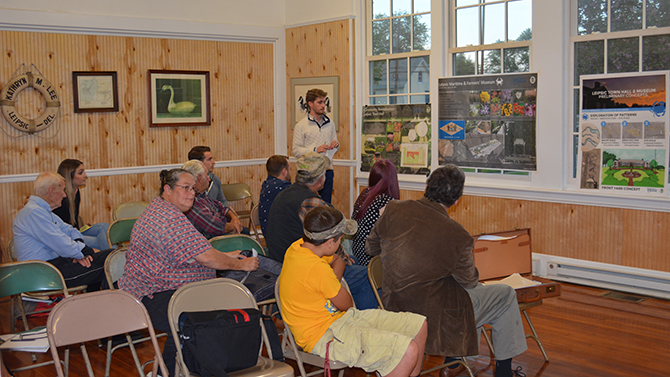


Developing landscapes
September 26, 2016
UD student spends summer working with Leipsic, Laurel communities
Working as a community redevelopment and design intern to help implement and develop the landscape design plans for Leipsic Town Hall and the Laurel Ramble was just about the perfect way for the University of Delaware’s Austin Virdin to spend his summer.
Virdin, a senior majoring in landscape architecture in UD’s College of Agriculture and Natural Resources, was involved with the town hall project from its inception, as some of the plans originated in the Ecological Planting Design class taught by Jules Bruck, associate professor of landscape design.
Leipsic is a small, picturesque community located on the Leipsic River in Kent County, Delaware.
“We took on the town hall landscape design, met with town council, proposed our ideas, and all produced final designs. My task in the internship was to take all the student design work and develop a final product with the components that town council liked and everything that members of the community wanted,” said Virdin. “After combining everything into one design, I then produced the planting plan to bring it to fruition.”
Virdin said the concept is now becoming a reality, as the design he created with Bruck was approved by the town council with the hope that it might be installed in the fall.
The Leipsic landscaping project grew out of the Working Waterfronts Initiative in the community for which Ed Lewandowski, acting marine advisory services director for Delaware Sea Grant and coordinator for the University’s Sustainable Coastal Communities Initiative (SCCI), which is housed in UD’s College of Earth, Ocean, and Environment (CEOE), was the principal investigator.
SCCI launched the Working Waterfronts Initiative in 2012 to develop sustainability strategies for preserving and maintaining the state’s traditional maritime communities. When members of Leipsic’s museum committee approached Lewandowski about assisting with development of their maritime and agricultural museum, he connected them with Bruck.
“I've had the privilege of collaborating with Dr. Bruck on community engagement projects in other Delaware municipalities, so I recognize the tremendous talent and value that she and her students can add to this type of cross-disciplinary, cross-college project,” said Lewandowski.
With the new design, Virdin said the building will be a gathering space for the community instead of being used just once a month for town council meetings.
“In the rear of the property we designed an open green space surrounded by a wooded planting. The intent of this is to create a defined gathering space that can serve a variety of purposes such as for festivals or meetings. The intent is for it to become a space that the community benefits from more than just once a month,” said Virdin.
Virdin said that he is looking forward to seeing the project come to life after being involved with it from the earliest design stage in the classroom to actual implementation.
“I enjoy these kinds of projects where we create the concept plan, and it is not only liked by people and approved but it is also implemented. I think that’s pretty rewarding to see the work that you created come to life in that sense,” said Virdin. “Some of the other projects we worked on in that class have been implemented in Newark but this project has been more meaningful to me as Leipsic is about 10 minutes from where I live in Dover. It has been a great opportunity to work down there.”
The Ramble
Virdin also spent time during his internship working with Bruck and Lewandowski on the Laurel Ramble project in Sussex County, Delaware.
Bruck and Lewandowski have been working on the project for the past few years, and Virdin, whose internship was run through Bruck’s Evolution Landscape Design business and funded through Delaware Sea Grant, said he helped with some of the detailed specifications, as most of the concept had already been designed.
These specifications included developing a pattern book for future business and home developers to use as a reference.
“Laurel just received a downtown development district designation from the state of Delaware which will spur development in the area. Through this pattern book, we’re looking to the future by setting guidelines that will define Laurel. Instead of an assortment of different architectural styles and colors, our mission is to create a unified feeling throughout the town that is unique to Laurel,” said Virdin.
The pattern book will include everything from colors that are approved by the town, approved designs for signage displays that will be facing the street, and styles of molding, shutters and windows.
“We also included a section with approved plants and a garden design for the town. This way, we can exclude plants that are invasive or alien, and recommend ones that would be beneficial or are native. Our intent is to inform the residents about what plants should be excluded from their landscape,” said Virdin.
Virdin said his favorite part of the internship was being able to attend town council meetings and speak with residents about what they wanted to see implemented in the space.
“It was nice to not only create designs, and have those designs implemented, but also to work with small towns that I would not necessarily have the opportunity to work with. These towns function completely differently than a city like Newark, which is not a large city by any means, but has greater complex workings than a town like Leipsic or Laurel. Actually being in those town council meetings and talking to residents, getting their input, was the most meaningful and helpful aspect in all the design work that I worked on,” said Virdin.
Contact Us
Have a UDaily story idea?
Contact us at ocm@udel.edu
Members of the press
Contact us at 302-831-NEWS or visit the Media Relations website

